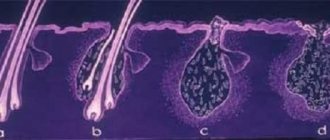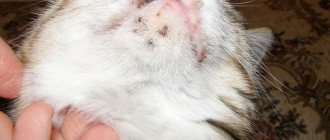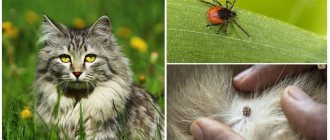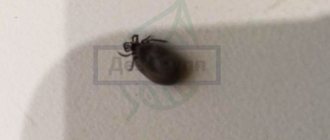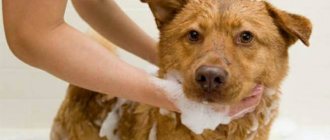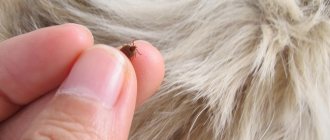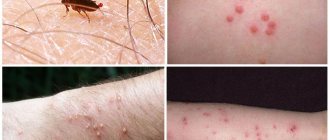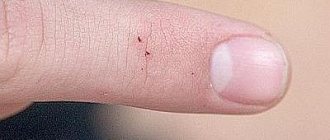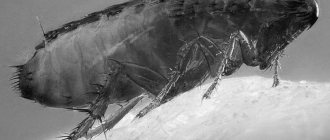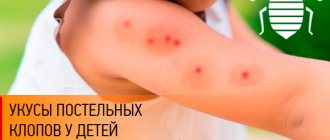Many people know about ixodid ticks that carry piroplasmosis, but only a few know about their closest relatives (microscopic Demodex canis). These tiny parasites, whose length does not exceed 0.3 mm, cause demodicosis in dogs - a dangerous pathology, often complicated by secondary infection. A sick pet may die from exhaustion or sepsis, so it is very important not to lose sight of the first alarming symptoms.
What is demodicosis in dogs?
Biologists have discovered more than a hundred species of Demodex; only three parasitize dogs:
- Demodex canis;
- Demodex cornei;
- Demodex injai.
Hundreds of studies have been published on these parasites, but questions still remain. In many publications, the demodex mite is described as a permanent inhabitant of the skin of all dogs, which multiplies when the immune system fails. This information is contradicted by a study of scrapings from healthy dogs without external signs of demodicosis. Of the 415 animals, only 36 were found to have ticks. The results of the study are described in a textbook on veterinary medicine.
A subcutaneous mite cannot be seen without a microscope; its body length does not exceed 0.26 mm. Once on the skin, the parasite penetrates into the cavity of the hair follicle, sebaceous glands and excretory ducts. As it moves, it gnaws out paths in the epithelium, destroying the cells of the follicle, epidermis, and hair roots.
The life cycle of demodex lasts 25–30 days. During this time, the female lays dozens of eggs in the hair follicles. As the colony of parasites multiplies, it grows and conquers new living space. And the animal develops a demodectic focus.
Any dog can get demodicosis, regardless of gender, age and breed. But according to observations, the subcutaneous mite more often attacks short-haired animals:
- French, English, American bulldogs;
- Rottweilers;
- boxers;
- Dobermans;
- bull terriers;
- dachshund;
- German Shepherds and Great Danes;
- Staffordshire Terriers;
- Shar Pei.
Short hair does not protect well from external irritants, so dogs actively secrete sebum - a breeding ground for parasites.
Literature
- Beale, K., 2012. Feline demodicosis: a consideration in the itchy or overgrooming cat. Journal of Feline Medicine and Surgery 14 209-213
- Bensignor, E. 2003. Comparison of three diagnostic techniques for Demodex canis demodicosis in the dog. Prat Med Chir Anim Comp 38 167-171
- Miller, WH, Wellington, JR, Scott, DW, 1992. Dermatologic disorders of the Chinese Shar Peis: 58 cases (1981-1989). J Am Vet Med Assoc 200 986-990
- Mueller, R. S. 2004. Treatment protocols for demodicosis: an evidence-based review. Veterinary Dermatology 15 75-89
- Mueller, R.S., Bensignor, E., Ferrer, L., Holm, B., Lemarie, S., Paradis, M., Shipstone, M.A., 2012. Treatment of demodicosis in dogs: 2011 clinical practice guidelines.
- Veterinary Dermatology 23 86-96 Bond, R. 1998. Diagnosis and treatment of canine scabies. In Practice 20 308-315
- Curtis, C. F. 2004. Current trends in the treatment of Sarcoptes, Cheyletiella and Otodectes mite infestations in dogs and cats. Vet Dermatol. 15 108-14
- Carithers D, Crawford J, de Vos C, Lotriet A, Fourie J - Parasites & Vectors (2016) 9:635
Is canine demodicosis contagious to humans and other dogs?
People also suffer from demodicosis, but other species live on them: Demodex brevis and Demodex folliculorum. A dog tick can land on human skin, but will not be able to feed or reproduce and quickly dies in an alien environment.
With close, prolonged contact, adult ticks move from one dog to another. However, the likelihood of developing the disease depends on the state of the immune system. The risk group includes:
- weakened dogs;
- sick and recovering;
- elderly over 10 years old;
- puppies up to one year;
- animals with skin lesions.
A healthy dog with a normal immune system will not get demodicosis even after close contact with a sick animal.
Dog ticks are not dangerous for cats. They are parasitized by other species of Demodex - Demodex gatoi, Demodex cati.
Forms of demodicosis in dogs
Based on the area of damage, there are 2 forms:
- Localized – up to 4 demodectic lesions up to 2.5 cm in size.
- Generalized – 5 or more scattered affected areas or extensive skin damage. This form occurs as a continuation of an untreated focal form or develops independently.
The division is conditional, since the ratio of the size of the dog and the affected areas is taken into account. For example, 3 lesions with a diameter of 2 cm for a Chihuahua are already generalized demodicosis, and 5 affected areas of 3 cm for a mastiff are a localized form of the disease.
Separately, pododemodecosis and otodemodecosis are distinguished. In the first case, lesions form on the paws and fingers. In the second, the parasite infects the surface of the ear.
Juvenile demodicosis in dogs under 1.5 years of age
Demodex mites are transmitted to puppies from their mother within 2–3 days after birth. Most kitties become asymptomatic carriers; the parasites do not affect health in any way. If the fragile immune system cannot cope and does not restrain the proliferation of parasites, by 3 months or later the puppy will develop demodicosis.
An additional burden in the 1st year of life is vaccinations, changing teeth, and cupping. These events can trigger stress, a dangerous enemy of the immune system. Focal juvenile demodicosis in 90% of cases goes away as the puppy grows up and develops immunity.
For the development of the generalized juvenile form, genetic prerequisites are needed. The reproduction of mites is inhibited by the T-link of the immune system, which recognizes and removes foreign agents. Dogs with defects in protective T cells are themselves prone to generalized demodicosis and pass this defect on to their offspring.
Causes of demodicosis in adult dogs
In animals older than 18 months, demodex mites more often “wake up” against the background of other disorders that reduce the overall immunity and barrier functions of the skin:
- bacterial, allergic dermatitis;
- hormonal imbalance;
- infection with worms;
- oncological diseases;
- autoimmune pathologies.
Dogs with impaired hair growth and decreased skin tone are predisposed to the development of demodicosis. It is easier for a subcutaneous mite to penetrate into the cavity of the follicle when the hair grows slowly after molting or the root does not adhere tightly to the walls of the hair follicle.
Often demodicosis begins when the hormonal balance changes. This happens during pregnancy, after estrus or long-term treatment with corticosteroids. Hormonal drugs save from severe inflammation, but lead to the death of lymphocytes and suppress the immune system.
During the treatment of demodicosis, corticosteroids are completely excluded.
Unbalanced nutrition, lack or excess of macro and micronutrients affects the condition of the skin and disrupts protective functions. The dog's hair falls out, bald areas appear, skin tone decreases, and dermatitis develops. As a result, favorable conditions are created for the spread of ticks.
Possible complications
The vital activity of parasites affects the functionality of the lymph nodes, kidneys, stomach, spleen and liver. Ticks block gaps in the capillaries, depriving internal organs of regular blood flow. Without timely treatment, this can be fatal.
Numerous tunnels gnawed by Demodex are filled with intercellular fluid. A moist and warm environment attracts bacteria, which easily make their way through wounds. Having avoided a collision with immune cells, a secondary infection aggravates the existing condition, provoking the transition of the disease to a generalized form.
Symptoms of demodicosis in dogs
The initial stage proceeds unnoticed. The fur is thinning in places. Skin color does not change. There is little or no itching. Well-being and behavior remain the same. As the tick spreads, the disease takes on a scaly (squamous), pustular or mixed clinical form.
At an early stage, a demodectic lesion seems harmless.
Signs of scaly demodicosis
The development of this form is indicated by the following symptoms:
- The dog develops round bald areas with clear boundaries with a diameter of 1 to 20 mm. More often they appear on the face, around the eyes, on the forehead, and limbs.
The initial stage of scaly demodicosis.
- The skin on hairless areas turns slightly red, flakes, and becomes covered with scales.
- The fur at the border of the demodicosis lesion does not stay in the follicles and falls out.
- Gradually, the skin becomes rougher, cracks, and dense nodules appear on it.
- At a later stage, the color changes to bluish-gray with red inclusions.
In the scaly form, the animal does not suffer from itching. It begins when a secondary bacterial or fungal infection occurs. Body temperature often drops to 37℃.
Symptoms of pustular demodicosis
This form develops if pathogenic or conditionally pathogenic bacteria multiply in the demodicosis lesion:
- The skin turns red, swells, and becomes covered with nodules.
- Gradually they turn into yellow, brown, black bubbles with liquid.
- When the pustules open, pus flows out, sometimes with traces of blood. After drying, crusts form.
- The skin thickens, wrinkles, becomes cracked, and smells bad. Ulcers form at the site of burst pustules.
With otodemodecosis, the ears become swollen, hot, and painful. The inner surface turns red, sulfur is released intensely, and itching occurs. Demodicosis of the paws is painful. While walking, the dog rubs the injured skin. In addition to the standard symptoms, lameness occurs.
Analysis for demodicosis in dogs
It is impossible to make an accurate diagnosis based on external signs. Symptoms of demodicosis are similar to clinical signs of other diseases:
- Bacterial skin infections - folliculitis, pyoderma, impetigo, furunculosis.
- Fungal infections - trichophytosis, microsporia.
- Allergic diseases – flea infestation, atopic dermatitis, food sensitivity.
- Infection with scabies mites - sarcoptic mange.
- Thyroid dysfunction and hormonal imbalance – hypothyroidism.
The final diagnosis is made after microscopic analysis. The doctor makes a deep scraping from the lesion with a scalpel until a drop of blood appears. Then he transfers the materials onto glass smeared with Vaseline. Sexually mature individuals, larvae, and eggs are easily visible under a microscope. After counting the parasites at different stages, an acarogram is displayed.
Demodex mites under a microscope
If single adult individuals are found, then up to 5 repeated scrapings are made from the affected and healthy areas. In sensitive areas, such as around the eyes, instead of skin, a hair pluck is taken for analysis.
Additional studies will be needed to identify concomitant disorders:
- clinical urine test,
- blood biochemistry;
- coprogram;
- hormonal analysis of blood serum;
- bacterial culture to determine the sensitivity of the microflora if antibiotics are prescribed.
During treatment, scrapings are repeated every 3 to 4 weeks until not a single tick is found in at least two samples at a monthly interval.
Diagnostics
The symptoms and treatment of acariasis are well known to veterinarians. But before you find out how to treat subcutaneous mites in dogs, a specialist must examine the animal.
Diagnosis of demodicosis involves a doctor studying clinical symptoms, as well as taking scrapings from pathological areas of the skin.
When making an accurate diagnosis, the factor of heredity is taken into account. And if puppies are sick, the mother is also tested.
To determine the presence of mites, scraping is done so deep that blood leaks out. In the complicated form of the disease, many adult parasites and future offspring of parasites are identified. If no mites are found in the biopsy specimen, but the clinical picture clearly makes it clear that they are present, then a repeat scraping is performed. In this case, the biomaterial is collected from another affected area.
Treatment of focal and generalized demodicosis in dogs
There is no general treatment regimen for all dogs. When choosing drugs, a lot of details are taken into account: age, heredity, area and shape of the lesion, test results, severity of symptoms, concomitant diseases.
According to the observations of veterinarians, focal uncomplicated demodicosis resolves spontaneously in 90% of dogs. But you should not hope for a successful outcome; the development of the disease cannot be predicted.
Treatment of the focal form includes the following areas:
- Cleansing demodicosis lesions.
- Treatment with acaricidal solutions, ointments or drops to reduce the population and destroy the tick.
- Treatment with ointments to restore skin, coat and prevent secondary infections.
In the generalized form the following are added:
- Systemic acaricidal drugs in the form of injection solutions or tablets.
- Antibiotics or external antiseptics to prevent and treat bacterial infections in the affected area.
- Antimycotics for suspected fungal development in a demodectic lesion.
Treatment should not be stopped until 2 negative laboratory tests are obtained, even if external symptoms subside. The drugs destroy adult ticks, but do not affect parasite eggs. When treatment is interrupted prematurely, they become more active, develop into sexually mature individuals, and demodicosis returns.
Shampoos
Before treatment, the hair around demodectic lesions is cut off. The dog is bathed to remove particles of damaged skin and excess fat. The effect of antiparasitic drugs is enhanced on a cleaned surface.
Here are examples of veterinary medicated shampoos with antibacterial and keratolytic properties:
- Peroxiderm. Benzoyl peroxide is added to the composition. This substance disinfects the affected area, regulates the secretion of skin secretions, and gently removes scales and crusts.
- Doctor - a line of shampoos with medicinal additives. The cleanser contains benzoyl peroxide. When pustules appear, use shampoo with chlorhexidine. When the lesions stop peeling, becoming covered with bubbles and crusts, they switch to restorative shampoos with birch tar or prebiotics and D-panthenol.
- DermaPet is a line of American dermatological shampoos. For demodicosis, use DermaBenSs. In addition to benzoyl peroxide, the composition contains 1% sulfuric and salicylic acids. These components disinfect and dry the skin. Sensitive dogs can be washed with the hypoallergenic DermaLyte shampoo from this range.
After bathing, the dog is not dried so as not to spread ticks. The wool is carefully blotted and dried with a hairdryer or allowed to dry naturally.
Acaricidal solutions for local treatment
All anti-tick medications contain toxic substances, so before treatment the dog is given a protective collar or the jaws are secured with a ribbon. Here are examples of solutions ready for application:
- Amitrazine – contains 3 main components. Amitraz causes paralysis and death of ticks. Dimexide relieves inflammation. Rapeseed oil restores skin. Amitrazine labeled “Plus” contains the antiseptic, antifungal substance decamethoxin. The solution is applied once every 5–7 days until recovery, Amitrazine Plus is applied every 3 days. To treat demodicosis, 5 to 8 procedures are usually enough.
- Prazicide complex is a solution based on a combination of ivermectin and praziquantel, which is harmful to demodex. The additional component levamisole stimulates local immunity by increasing the number of T-lymphocytes. The drug is applied to the affected areas at intervals of 10–14 days.
- Amit forte – combines 3 active substances. Fipronil destroys larvae and adult parasites. Diphenhydramine reduces itching and discomfort. Diflubenzuron interferes with the synthesis of chitin and disrupts the life cycle of the tick. The animal is treated 3–5 times with a time interval of 5–7 days.
- Decta - in addition to amitraz, contains chloramphenicol, which stops the growth of harmful bacteria. The auxiliary component propolis disinfects and accelerates skin restoration. The solution is used every 5 - 7 days until recovery.
Before treatment, scales and scabs are removed from the lesion with a cotton-gauze swab dipped in warm water or an antiseptic - chlorhexidine, miramistin. Antimicrobial solutions have no effect on ticks, but prevent the development of secondary infections.
The preparations are applied in a thin layer directly to the affected area from the borders to the center, covering 1 cm of healthy skin. Large areas are treated in 2 steps: first one half, then the other half a day later. After application, wait 20 minutes for the liquid to be absorbed, and only then remove the protective collar.
Acaricidal ointments
Instead of solutions, you can treat the lesions with ointments. They add glycerin, which softens and moisturizes the skin:
- Amidel gel - contains amitraz, lidocaine for local anesthesia, methyluracil to accelerate skin regeneration.
- Aversectin ointment is based on the aversectin C complex, which is destructive for larvae and mature individuals of Demodex canis.
The ointments are rubbed in every 5-7 days until complete recovery.
Acaricidal drops on the withers
The drugs are applied dropwise at the base of the skull and along the spine in 3 to 4 places. After treatment, the active ingredients are evenly distributed in the epidermis, follicles, and sebaceous glands:
- Advocate - the first licensed drops against demodex mites. The product contains a combination of imidacloprid and moxidectin. In mild cases, treatments are repeated every 3-4 weeks, in complicated cases - every 7 days.
- Promeris Duo - drops based on a combination of amitraz and metaflumizone. The drug effectively kills demodex mites, but often causes an allergic reaction.
- Dironet Spot it contains ivermectin and praziquantel. The dog is treated once every 10–14 days until recovery.
Drops on the withers work well with isolated lesions. In severe cases, they are included in complex therapy.
Restorative ointments
At the same time, they use products to reduce irritation, redness, discomfort, and prevent secondary infections:
- Sulfur ointment is a harmless remedy against inflammation, the formation of bacteria and fungus, and stops the spread of mites.
- Fir - contains pine resin, beeswax and foundation. The product improves blood circulation, resolves inflammation, disinfects and restores the skin.
- Vedinol is a line of ointments for the treatment of inflammation of the subcutaneous tissue and skin based on pine oil. An acaricidal phytocomplex has been added to Vedinol marked “plus”. The series includes an ointment specifically for paws. It helps with the appearance of redness and chafing in the affected area.
Acaricidal preparations for injections
For the generalized form, drugs based on avermectins are traditionally used. These are biopesticides that are harmful to ticks and are obtained from the decay products of the fungus Streptomyces avermitilis.
The avermectin series includes solutions containing ivermectin, aversectin, doramectin:
- Ivermek;
- Ivertin;
- Baymek;
- Aversect;
- Noromectin;
- Novomek;
- Ivomek;
- Dectomax.
The listed drugs are administered using intramuscular or subcutaneous injections or infused through the mouth according to the scheme. The safest from this list is Aversect. It is produced specifically for dogs and cats and has fewer side effects. The exact dosage, methods of administration, treatment regimen are prescribed in the instructions for Aversect for dogs.
The remaining solutions are intended for farm animals, although they cope with the canine type of demodex. Violation of the dosage results in severe complications, so the treatment regimen is prescribed only by the attending physician for a specific animal.
Avermectin drugs have been used to treat demodicosis for a long time, so they have become less effective against subcutaneous mites. Sometimes they turn out to be useless and have to be replaced with drugs from other groups.
Treatment of demodicosis in dogs with Bravecto and analogues
The active ingredients of Bravecto and similar tablets belong to the chemical class of isoxazolines. Substances of this group disrupt the connection between neurons, immobilize and destroy ticks. They have been used in veterinary medicine relatively recently; cases of Demodex resistance have not yet been identified.
Bravecto was invented to protect against ixodid ticks and fleas. Then it turned out that the drug copes with advanced demodicosis. Tablets are produced for 5 weight categories of animals from 2 to 56 kg. The active substance fluralaner enters the bloodstream and is slowly eliminated over 3 months. Tablets are given with food or after meals once every 12 weeks until recovery.
Other pharmaceutical companies have also released isoxazoline tablets:
- Frontline Nexgard . The active substance is afoxolaner. For demodicosis, during the first month, 2 single doses are fed at a two-week interval. Then they continue to give once a month. A detailed description of Frontline Nexgard is in the official instructions.
- Nexguard Spectra. The drug contains 2 active ingredients: afoxolaner and milbemycin oxime. In the first month, tablets are taken twice with an interval of 14 days, then once a month until clinical recovery.
- Simparica. Tablets are available in 6 dosages. The smallest is for small dogs with a body weight of 1.3 - 2.5 kg. Other drugs of the isoxazoline group are allowed to be used with a weight of 2 kg or more. For demodicosis, tablets are fed monthly, regardless of feeding.
The active ingredients are distributed unevenly in the tablets, so they are given whole and not divided into parts.
Dog breeders will find it useful: How to cure a dog from piroplasmosis and how to protect it from ixodid ticks.
Antibacterial tablets
Pathogenic and opportunistic bacteria quickly multiply on damaged skin. When pustules and ulcers appear, external antiseptics are added to the treatment regimen, and in advanced cases, antibacterial tablets, for example:
- Amoxicillin. Veterinary suspension for subcutaneous and intramuscular injections. A noticeable improvement occurs after 1 – 2 injections with an interval of 48 hours. The medicine is administered at the rate of 1 ml/10 kg of animal weight.
- Tsiprovet . 1 tablet is designed for 10 kg of body weight. The required dose of medication is given once a day for 5 to 7 days. In a preparation marked “for cats, small dogs and puppies,” 1 tablet is designed for 3 kg of body weight.
- Sinulox – veterinary tablets of 50, 250 and 500 mg. A single dose is 12.5 mg/1 kg of dog weight. The medicine is fed twice a day with an interval of 12 hours for 5 - 7 days. In advanced cases, it is allowed to increase the single dose to 25 mg/1 kg and extend treatment to 10–28 days. A complete analogue of Sinulox is veterinary tablets Xiclav.
The therapeutic effect of antibiotics is reduced if you interrupt the course ahead of time or skip a dose.
Immunity restoration
For any form of demodicosis, create the most favorable conditions for strengthening the dog’s immunity:
- The pet is examined and concomitant diseases are treated if they are detected.
- At home, the conditions of detention are analyzed. Demodex mites love warm, moist environments. The dog's place is located away from radiators. On the street they do not put you in a damp booth or enclosure. The bedding is kept clean, often washed in hot water or changed.
- Carefully protects from stress. Loud noises, unfamiliar people and new animals in the house, and harsh treatment become sources of nervous tension. Some dogs do not tolerate loneliness or travel well, and take a long time to get used to changes.
- Reviewing the diet. When eating natural food, do not overfeed with carbohydrates - cereals, pasta, bread. They do not give sweets, pastries, sausage, bones, or food from the common table. Avoid dry food with low protein content. Do not mix homemade products and industrial feed.
- To restore the skin and coat, it is useful to take a course of injections of the Catozal stimulating solution, add feed sulfur to food at the rate of 0.04 g per 1 kg of weight per day, but not more than 1 g per dog.
In the focal form, these measures are sometimes enough to restore the immune status and stop the spread of demodex. In difficult cases, Immunoparasitan, Fosprenil, Maxidin are included in complex treatment.
There is no consensus in the veterinary community regarding immunomodulators. Many do not see any benefit from them, since the effect of immunostimulants on the immune system that inhibits demodicosis has not been proven.
Features of nutrition during the treatment period
The vital activity of ticks is accompanied by the active production of toxins that disrupt the process of food digestion. To restore the functions of the gastrointestinal tract, the patient is put on a gentle diet. It provides:
- Elimination of fatty and heavy foods. The main emphasis is on chicken breast, beef tenderloin and oatmeal.
- Refusal to reheat. Don't cook several days ahead. Food should not only be of high quality, but always fresh. It is also worth monitoring her temperature. When served, it should correspond to room temperature.
- Transition to fractional meals. Reduce the single portion, increasing the number of feedings to 4-5 per day.
- Monitoring adequate fluid intake. Change the water in the bowl regularly and include rosehip infusions in your daily menu.
When feeding dry kibble, it is recommended to switch to a special line for allergy sufferers. It can be found from manufacturers that produce products of at least premium class.
Forecast
Focal demodicosis disappears without a trace within 1 to 3 months. Treatment of the generalized form lasts from six months or longer. The indicator of clinical recovery is 2 negative tests of skin scrapings with an interval of 1 month. But a complete cure is stated when there are no relapses throughout the year.
With a generalized form in juvenile age, the risk of the disease returning in the future increases, since this often happens due to genetically determined immunity disorders. Such animals require increased attention and painstaking care.
conclusions
Ticks pose a danger not only to animals, but also to humans. To avoid infection, follow preventive measures and purchase a special protective suit for your pet. In this case, it will be very difficult for parasites to get into their favorite areas of the body.
Pay attention to the following points:
- The presence of scabies is an important, but not obligatory, point of mite infestation. In rare cases, the dog does not suffer from itching, but is sure to lick small wounds from bites.
- Demodicosis is an unpredictable and dangerous disease that requires constant monitoring. If your pet is on the mend, don’t let your guard down. Any violation is fraught with relapse, so visit the veterinarian for prevention at least 2 times a year.
- All acaricidal drugs are toxic. Dosages are selected individually, and especially strong drugs (Dectomax) are allowed to be used only under the supervision of a doctor. Self-medication is strictly prohibited.
Be sure to check your pet after finishing your walk. Carry out a more thorough inspection during seasonal tick activity, which increases their concentration outdoors. Remember that if you have any suspicions, professional help is needed. An erroneous diagnosis made independently can lead to the death of a pet due to improper treatment.
Prevention of demodicosis in dogs
The main task is to eliminate conditions for the reproduction of ticks, which means maintaining the dog’s immunity:
- Once a quarter, the pet is taken for a preventive veterinary examination in order to identify hidden diseases at an early stage and treat them in a timely manner.
- Do not violate the vaccination schedule.
- The pet's area is kept clean and dry.
- Balanced food.
- Contact with obviously sick animals is limited.
- Regularly treated against external and internal parasites.
To prevent parasitic diseases, it is better to use universal remedies so as not to give several drugs. Bravecto, Simparica, and Frontline Nexgard tablets protect against ixodid, demodectic, ear, sarcoptic ticks and fleas. Nexgard Spectra, Advocate drops, in addition to the listed parasites, destroy roundworms and heartworm larvae.
Demodicosis in dogs is an unpleasant but curable disease, photos, treatment, symptoms depend on the clinical form and area of the lesion.
It is possible to defeat parasites!
Antiparasitic Complex® - Reliable and safe removal of parasites in 21 days!
- The composition includes only natural ingredients;
- Does not cause side effects;
- Absolutely safe;
- Protects the liver, heart, lungs, stomach, skin from parasites;
- Removes waste products of parasites from the body.
- Effectively destroys most types of helminths in 21 days.
There is now a preferential program for free packaging. Read expert opinion.
Read further:
Advocate against worms and fleas for cats and dogs: instructions for use, price, reviews
Demodex Folliculorum mite (acne ironweed): description, development cycle and treatment methods
Yam ointment for demodicosis for humans: how to use, price, instructions
Soap for demodicosis (tar, laundry): how to use for treatment
Birch tar for parasites: dosage regimen, how to properly apply internally
Demodectic mange in cats: symptoms and drug treatment regimen
